Lipids
Sakshi Education

Lipids are a class of hydrocarbon-containing organic compounds essential for the structure and function of living cells. Lipids are characterized by being water-insoluble and soluble in nonpolar organic solvents. Although the term lipid is often used as a synonym for fat, the latter is in fact a subgroup of lipids called triglycerides.
The basic classes of lipids are:
Fatty acids
Fats (Glycerides) and Oils:

Triglycerides having three identical acyl chains, such as tristearin and triolein (above), are called "simple", while those composed of different acyl chains are called "mixed". If the acyl chains at the end hydroxyl groups (1 & 3) of glycerol are different, the center carbon becomes a chiral center and enantiomeric configurations must be recognized.
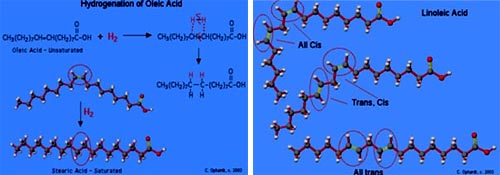 Hydrogenation: Hydrogenation is the addition of hydrogens leads to the conversion of unsaturated to saturated fatty acids. Partial hydrogenation of vegetable oils that is some , but usually not all, of the double bonds in each molecule have been reduced. Hydrogenation results in the conversion of liquid vegetable oils to solid or semi-solid fats, such as those present in margarine.
Hydrogenation: Hydrogenation is the addition of hydrogens leads to the conversion of unsaturated to saturated fatty acids. Partial hydrogenation of vegetable oils that is some , but usually not all, of the double bonds in each molecule have been reduced. Hydrogenation results in the conversion of liquid vegetable oils to solid or semi-solid fats, such as those present in margarine.
 Phospholipids: Phospholipids are a class of lipids formed from four components: fatty acids, a negatively charged phosphate group, nitrogen containing alcohol and a backbone. Phospholipids with a glycerol backbone are known as glycerophospholipids or phosphoglycerides. There is only one type of phospholipid with a sphingosine backbone; sphingomyelin. Phospholipids are a major component of all biological membranes, along with glycolipids and cholesterol.
Phospholipids: Phospholipids are a class of lipids formed from four components: fatty acids, a negatively charged phosphate group, nitrogen containing alcohol and a backbone. Phospholipids with a glycerol backbone are known as glycerophospholipids or phosphoglycerides. There is only one type of phospholipid with a sphingosine backbone; sphingomyelin. Phospholipids are a major component of all biological membranes, along with glycolipids and cholesterol.
Phosphotidyl choline: Phosphatidyl choline is the major component of lecithin. It is also a source for choline in the synthesis of acetylcholine in cholinergic neurons.
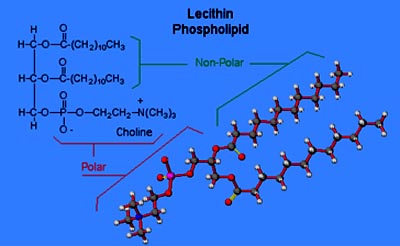
Lecithin is probably the most common phospholipid. It is found in egg yolks, wheat germ, and soybeans. Lecithin is extracted from soybeans for use as an emulsifying agent in foods. Lecithin is an emulsifier because it has both polar and non-polar properties, which enable it to cause the mixing of other fats and oils with water components.
Phosphotidyl ehanalamine:
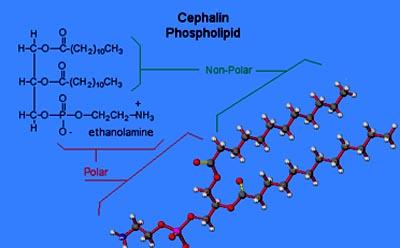
Phosphatidyl ethanolamine is the major component of cephalin. Cephalins are found in most cell membranes, particularly in brain tissues. They are also important in the blood clotting process as they are found in blood platelets.
Phosphotidyl serine:
Phosphatidylserine is a phospholipid nutrient found in fish, green leafy vegetables, soybeans and rice, and is essential for the normal functioning of neuronal cell membranes. In apoptosis, phosphatidylserine is transferred to the outer leaflet of the plasma membrane. This is part of the process by which the cell is targeted for phagocytosis. Phosphatidylserine (PS) has been used to slow cognitive decline in early-onset Alzheimer's disease

Phosphatidylinositol:
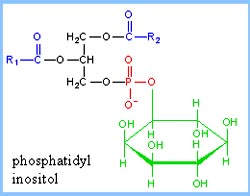
Phosphatidylinositol (abbreviated PtdIns, or PI) is a minor phospholipid component of mammalian cell membranes. It is however the substrate for a large number of enzymes which are involved in cell signalling.
Diphosphatidyl glycerol (Cardiolipin):
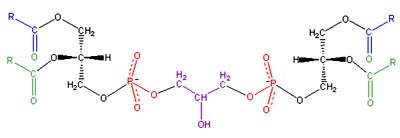
Cardiolipin (bisphosphatidyl glycerol) is an important component of the inner mitochondrial membrane, where it constitutes about 20% of the total lipid. It is typically present in metabolically active cells of the heart and skeletal muscle. It has also been observed in certain bacterial membranes. It serves as an insulator and stabilizes the activity of protein complexes important to the electron transport chain. Cardiolipin is a "double" phospholipid because it has four fatty acid tails, instead of the usual two.
Sphingomyelin: Sphingomyelin is a type of lipid involved in the nervous system of animals, used to increase the speed of transmission. It consists of sphingosine to which two fatty acids are attached. The two fatty acids and the sphingosine are held together by ester bonds.

The sphingomyelins are also membrane lipids. They are the major component of the myelin sheath surrounding nerve fibers. Multiple Sclerosis is a devastating disease in which the myelin sheath is lost, causing eventual paralysis.
Glycolipids (Glycosphingolipids): Glycolipids are carbohydrate-attached lipids. Their role is to provide energy and also serve as markers for cellular recognition.
They are classified as
1. Cerebrosides
2. Gangliosides
Cerbrosides:A cerebroside is a sphingolipid (ceramide) with a monosaccharide such as glucose or galactose as polar head group.

Glucocerebrosides are present in the spleen and non-nervous tissue where as galactocerebrosides are present in the nervous tissue.
According the nature of the fatty acid residue, there are four main types of cerebrosides in the nerve tissue, 
Bile acids: Bile acids are steroid acids found predominantly in the bile of mammals. They are produced in the liver by the oxidation of cholesterol, and are stored in gallbladder and secreted into the intestine in the form of salts. They act as surfactants, emulsifying lipids and assisting with their absorption and digestion. In humans, the most important bile acids are cholic acid and chenodeoxycholic acid, and their conjugates with taurine and glycine (glycocholate and taurocholate) – Bile salts. Some mammals synthesize predominantly deoxycholic acid.
Sex Hormones:
Many plant aromatic oils are terpenes. Taxol, an extract from yew, is used to treat ovarian cancer, and digitalin is a cardiac medicine. Two plant hormones are also terpenes, as are two important electron transfer molecules. Economically, rubber is an important terpene. Terpenes are lipid soluble and hydrophobic
Plant terpenoids are extensively used for their aromatic qualities. They play a role in traditional herbal remedies and are under investigation for antibacterial, antineoplastic and other pharmaceutical effects. Terpenoids contribute to the scent of eucalyptus, the flavors of cinnamon, cloves and ginger and the color of yellow flowers. Well-known terpenoids include citral, menthol, camphor and the cannabinoids found in the Cannabis plant.
Waxes: Waxes are esters of fatty acids with long chain monohydric alcohols (one hydroxyl group). Natural waxes are often mixtures of such esters, and may also contain hydrocarbons. The formulas for three well known waxes are given below, with the carboxylic acid moiety colored red and the alcohol colored blue.
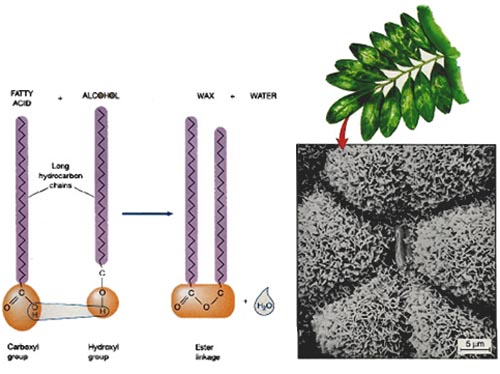
Waxes are widely distributed in nature. The leaves and fruits of many plants have waxy coatings, which may protect them from dehydration and small predators. The feathers of birds and the fur of some animals have similar coatings which serve as a water repellent. Carnuba wax is valued for its toughness and water resistance.
The basic classes of lipids are:
Fatty acids
- Saturated
- Unsaturated
- Monoglycerides
- Diglycerides
- Triglycerides (neutral fats)
- Phosphoglycerides or glycerophospholipids
- Sphingolipids
- Sterol lipids (includes cholesterol and steroid hormones)
- Prenol lipids (includes terpenoids)
- Waxes
- Polyketides
- Sugar-linked lipids: glycolipids
- Protein-linked lipids
Fatty Acids: Chemically, fatty acids can be described as long-chain monocarboxylic acids and have a general structure of CH3 (CH2)nCOOH. The length of the chain usually ranges from 12 to 24, always with an even number of carbons. When the carbon chain contains no double bonds, it is called saturated. If it contains one or more such bonds, it is unsaturated. The presence of double bonds generally reduces the melting point of fatty acids. Furthermore, unsaturated fatty acids can occur either in cis or trans geometric isomers. In most naturally occurring fatty acids, the double bonds are in the cis configuration.
Nomenclature:
There are two different ways to make clear where the double bonds are located in molecules.
For example:
Cis/Trans-Delta-x or cis/trans- Dx: The double bond is located on the xth carbon-carbon bond, counting from the carboxyl terminus. The cis or trans notation indicates whether the molecule is arranged in a cis or trans conformation. In the case of a molecule having more than one double bond, the notation is, for example, cis,cis-D9, D12.
Omega-x or ?w-x: A double bond is located on the x th carbon-carbon bond, counting from the w, (methyl carbon) end of the chain.
Nomenclature:
There are two different ways to make clear where the double bonds are located in molecules.
For example:
Cis/Trans-Delta-x or cis/trans- Dx: The double bond is located on the xth carbon-carbon bond, counting from the carboxyl terminus. The cis or trans notation indicates whether the molecule is arranged in a cis or trans conformation. In the case of a molecule having more than one double bond, the notation is, for example, cis,cis-D9, D12.
Omega-x or ?w-x: A double bond is located on the x th carbon-carbon bond, counting from the w, (methyl carbon) end of the chain.
| Numerical Symbol | Common Name | Structure | Melting Point | Comments |
| 12:0 | lauric acid | CH3(CH)10COOH | 45 ºC | |
| 14:0 | Myristic acid | CH3(CH2)12COOH | 55 ºC | Often found attached to the N-term. of plasma membrane-associated cytoplasmic proteins |
| 16.0 | Palmitic acid | CH3(CH2)14 COOH | 63 ºC | End product of mammalian fatty acid synthesis |
| 16:1D9 | Palmitoleic acid | CH3(CH2)5C=C(CH2)7COOH | 0 ºC | |
| 18:0 | Stearic acid | CH3(CH2)16COOH | 69 ºC | |
| 18:1 D9 | Oleic acid | CH3(CH2)7CH=CH(CH2)7COOH (cis) | 13 ºC13 ºC | |
| 18:1D9 | Elaidic acid | CH3(CH2)7CH=CH(CH2)7COOH (trans) | 45 ºC | Isomer of Oleic acid |
Fats (Glycerides) and Oils:
Glycerides are esters formed from glycerol and fatty acid. Glycerol has three hydroxyl functional groups and which can be esterified with one, two or three fatty acids to form monoglycerides, diglycerides and triglycerides.
Vegetable oils and animal fats contain mostly triglycerides, but are broken down by natural enzymes (lipases) into mono- and diglycerides and free fatty acids. Soaps often contain glycerides as well. Glycerol is a product that can soften dehydrated skin. It can absorb moisture from the air. These triglycerides (or triacylglycerols) are found in both plants and animals, and compose one of the major food groups of our diet.
Triglycerides that are solid or semisolid at room temperature are classified as fats, and occur predominantly in animals. Those triglycerides that are liquid are called oils and originate chiefly in plants, although triglycerides from fish are also largely oils. Some examples of the composition of triglycerides from various sources are given in the following table.
Vegetable oils and animal fats contain mostly triglycerides, but are broken down by natural enzymes (lipases) into mono- and diglycerides and free fatty acids. Soaps often contain glycerides as well. Glycerol is a product that can soften dehydrated skin. It can absorb moisture from the air. These triglycerides (or triacylglycerols) are found in both plants and animals, and compose one of the major food groups of our diet.
Triglycerides that are solid or semisolid at room temperature are classified as fats, and occur predominantly in animals. Those triglycerides that are liquid are called oils and originate chiefly in plants, although triglycerides from fish are also largely oils. Some examples of the composition of triglycerides from various sources are given in the following table.
| Saturated Acids (%) | Unsaturated Acids (%) | ||||||||
| Source | C10& less | C12 lauric | C14myristic | C16palmitic | C18stearic | C18oleic | C18linoleic | C18unsaturated | |
| Animal Fats butter | 15 | 2 | 11 | 30 | 9 | 27 | 4 | 1 | |
| lard | - | - | 1 | 27 | 15 | 48 | 6 | 2 | |
| human fat | - | 1 | 3 | 25 | 8 | 46 | 10 | 3 | |
| herring oil | - | - | 7 | 12 | 1 | 2 | 20 | 52 | |
| Plant Oils coconut | - | 50 | 18 | 8 | 2 | 6 | 1 | ||
| corn | - | - | 1 | 10 | 3 | 50 | 34 | - | |
| olive | - | - | - | 7 | 2 | 85 | 5 | - | |
| palm | - | - | 2 | 41 | 5 | 43 | 7 | - | |
| peanut | - | - | - | 8 | 3 | 56 | 26 | 7 | |
| sunflower | - | - | - | 3 | 3 | 19 | 76 | - | |

Triglycerides having three identical acyl chains, such as tristearin and triolein (above), are called "simple", while those composed of different acyl chains are called "mixed". If the acyl chains at the end hydroxyl groups (1 & 3) of glycerol are different, the center carbon becomes a chiral center and enantiomeric configurations must be recognized.
 Hydrogenation: Hydrogenation is the addition of hydrogens leads to the conversion of unsaturated to saturated fatty acids. Partial hydrogenation of vegetable oils that is some , but usually not all, of the double bonds in each molecule have been reduced. Hydrogenation results in the conversion of liquid vegetable oils to solid or semi-solid fats, such as those present in margarine.
Hydrogenation: Hydrogenation is the addition of hydrogens leads to the conversion of unsaturated to saturated fatty acids. Partial hydrogenation of vegetable oils that is some , but usually not all, of the double bonds in each molecule have been reduced. Hydrogenation results in the conversion of liquid vegetable oils to solid or semi-solid fats, such as those present in margarine. Phospholipids: Phospholipids are a class of lipids formed from four components: fatty acids, a negatively charged phosphate group, nitrogen containing alcohol and a backbone. Phospholipids with a glycerol backbone are known as glycerophospholipids or phosphoglycerides. There is only one type of phospholipid with a sphingosine backbone; sphingomyelin. Phospholipids are a major component of all biological membranes, along with glycolipids and cholesterol.
Phospholipids: Phospholipids are a class of lipids formed from four components: fatty acids, a negatively charged phosphate group, nitrogen containing alcohol and a backbone. Phospholipids with a glycerol backbone are known as glycerophospholipids or phosphoglycerides. There is only one type of phospholipid with a sphingosine backbone; sphingomyelin. Phospholipids are a major component of all biological membranes, along with glycolipids and cholesterol.Phosphotidyl choline: Phosphatidyl choline is the major component of lecithin. It is also a source for choline in the synthesis of acetylcholine in cholinergic neurons.

Lecithin is probably the most common phospholipid. It is found in egg yolks, wheat germ, and soybeans. Lecithin is extracted from soybeans for use as an emulsifying agent in foods. Lecithin is an emulsifier because it has both polar and non-polar properties, which enable it to cause the mixing of other fats and oils with water components.
Phosphotidyl ehanalamine:

Phosphatidyl ethanolamine is the major component of cephalin. Cephalins are found in most cell membranes, particularly in brain tissues. They are also important in the blood clotting process as they are found in blood platelets.
Phosphotidyl serine:
Phosphatidylserine is a phospholipid nutrient found in fish, green leafy vegetables, soybeans and rice, and is essential for the normal functioning of neuronal cell membranes. In apoptosis, phosphatidylserine is transferred to the outer leaflet of the plasma membrane. This is part of the process by which the cell is targeted for phagocytosis. Phosphatidylserine (PS) has been used to slow cognitive decline in early-onset Alzheimer's disease

Phosphatidylinositol:

Phosphatidylinositol (abbreviated PtdIns, or PI) is a minor phospholipid component of mammalian cell membranes. It is however the substrate for a large number of enzymes which are involved in cell signalling.
Diphosphatidyl glycerol (Cardiolipin):

Cardiolipin (bisphosphatidyl glycerol) is an important component of the inner mitochondrial membrane, where it constitutes about 20% of the total lipid. It is typically present in metabolically active cells of the heart and skeletal muscle. It has also been observed in certain bacterial membranes. It serves as an insulator and stabilizes the activity of protein complexes important to the electron transport chain. Cardiolipin is a "double" phospholipid because it has four fatty acid tails, instead of the usual two.
Sphingomyelin: Sphingomyelin is a type of lipid involved in the nervous system of animals, used to increase the speed of transmission. It consists of sphingosine to which two fatty acids are attached. The two fatty acids and the sphingosine are held together by ester bonds.

The sphingomyelins are also membrane lipids. They are the major component of the myelin sheath surrounding nerve fibers. Multiple Sclerosis is a devastating disease in which the myelin sheath is lost, causing eventual paralysis.
Glycolipids (Glycosphingolipids): Glycolipids are carbohydrate-attached lipids. Their role is to provide energy and also serve as markers for cellular recognition.
They are classified as
1. Cerebrosides
2. Gangliosides
Cerbrosides:A cerebroside is a sphingolipid (ceramide) with a monosaccharide such as glucose or galactose as polar head group.

Glucocerebrosides are present in the spleen and non-nervous tissue where as galactocerebrosides are present in the nervous tissue.
According the nature of the fatty acid residue, there are four main types of cerebrosides in the nerve tissue,
- Kerasin – Lignocerate (saturated C24)
- Nervon – unsaturated nervonate (C24 )
- Cerbron – cerebronate(alpha hydroxy lignocerate)
- Oxynervon – oxynervonate (alpha hydroxy nervonate)
Gangliosides: Ganglioside is a compound composed of a glycosphingolipid (ceramide and oligosaccharide) with one or more sialic acids (AKA n-acetylneuraminic acid) linked on the sugar chain. It is a component the cell plasma membrane which modulates cell signal transduction events. They have recently been found to be highly important in immunology. Natural and semisynthetic gangliosides are considered possible therapeutics for neurodegenerative disorders.
A disease of the accumulation of gangliosides is called "Gangliosidosis", which is a form of Lipid storage disorder. The gangliosidoses are two distinct genetic groups of diseases. Both are autosomal recessive and affect males and females equally.
Sterols: Sterols, or steroid alcohols are a subgroup of steroids with a hydroxyl group in the 3-position of the A-ring. They are amphipathic lipids synthetised from Acetyl coenzyme A. The overall molecule is quite flat. The hydroxyl group on the A ring is polar. The rest of the aliphatic chain is non-polar. The aliphatic ring is called as cyclopentano perhydro phenanthrene nucleus.

Steriods are classified as following-
Sterols: Cholesterol, Ergosterol, Coprosterol
Cholesterol:
A disease of the accumulation of gangliosides is called "Gangliosidosis", which is a form of Lipid storage disorder. The gangliosidoses are two distinct genetic groups of diseases. Both are autosomal recessive and affect males and females equally.
Sterols: Sterols, or steroid alcohols are a subgroup of steroids with a hydroxyl group in the 3-position of the A-ring. They are amphipathic lipids synthetised from Acetyl coenzyme A. The overall molecule is quite flat. The hydroxyl group on the A ring is polar. The rest of the aliphatic chain is non-polar. The aliphatic ring is called as cyclopentano perhydro phenanthrene nucleus.

Steriods are classified as following-
Sterols: Cholesterol, Ergosterol, Coprosterol
Cholesterol:
- Precursor to most steroid hormones and vitamin D
- Necessary for structure of nerve system cells
- Component of animal cell membranes – not found in plants
- Cholesterol is made in the liver from digested fatty acids

Bile acids: Bile acids are steroid acids found predominantly in the bile of mammals. They are produced in the liver by the oxidation of cholesterol, and are stored in gallbladder and secreted into the intestine in the form of salts. They act as surfactants, emulsifying lipids and assisting with their absorption and digestion. In humans, the most important bile acids are cholic acid and chenodeoxycholic acid, and their conjugates with taurine and glycine (glycocholate and taurocholate) – Bile salts. Some mammals synthesize predominantly deoxycholic acid.
Sex Hormones:
- Glucocorticoids – Cortisol
- Mineralocorticoids - aldosterone
- Sex Steriods
- Androgens – Testosterone & Dihydrotestosterone
- Estrogens - Estradiol, Estrone, Estriol
- Progestagens -Progesterone
- Vitamin D derivatives - Calcitriol
Terpenoids: Terprenoid ar a very large and important group of compounds which is made of simple repeating unit, the isoprenoid unit. This unit, many ingenious condensations, gives rise to such compounds as rubber, carotenoids, dolichol, Ubiquinone, steroids, beta-carotene.
| Classification | Isoprene units | Carbon atoms |
| Monoterpenes | 2 | C10 |
| Sesquiterpenes (Cedrol) | 3 | C15 |
| Diterpenes (eg. Vitamin A) | 4 | C20 |
| Sesterterpenes | 5 | C25 |
| Triterpenes (eg. Squalnene) | 6 | C30 |
Many plant aromatic oils are terpenes. Taxol, an extract from yew, is used to treat ovarian cancer, and digitalin is a cardiac medicine. Two plant hormones are also terpenes, as are two important electron transfer molecules. Economically, rubber is an important terpene. Terpenes are lipid soluble and hydrophobic
Plant terpenoids are extensively used for their aromatic qualities. They play a role in traditional herbal remedies and are under investigation for antibacterial, antineoplastic and other pharmaceutical effects. Terpenoids contribute to the scent of eucalyptus, the flavors of cinnamon, cloves and ginger and the color of yellow flowers. Well-known terpenoids include citral, menthol, camphor and the cannabinoids found in the Cannabis plant.
Waxes: Waxes are esters of fatty acids with long chain monohydric alcohols (one hydroxyl group). Natural waxes are often mixtures of such esters, and may also contain hydrocarbons. The formulas for three well known waxes are given below, with the carboxylic acid moiety colored red and the alcohol colored blue.

Waxes are widely distributed in nature. The leaves and fruits of many plants have waxy coatings, which may protect them from dehydration and small predators. The feathers of birds and the fur of some animals have similar coatings which serve as a water repellent. Carnuba wax is valued for its toughness and water resistance.
- Spermaceti - CH3(CH2)14CO2-(CH2)15CH3
- Beeswax - CH3(CH2)24CO2-(CH2)29CH3
- Carnuba wax - CH3(CH2)30CO2-(CH2)33CH3
Polyketides: Polyketides are secondary metabolites from bacteria, fungi, plants, and animals. Secondary metabolites seem to be unnecessary for an organism’s ontogeny, but appear to have applications such as defence and intercellular communication. Polyketides are derived from the polymerization of acetyl and propionyl subunits in a similar process to fatty acid synthesis. They also serve as building blocks for a broad range of natural products or are derivatized.
Polyketides are structurally a very diverse family of natural products with an extremely broad range of biological activities and pharmacological properties. Polyketide antibiotics
Polyketides are structurally a very diverse family of natural products with an extremely broad range of biological activities and pharmacological properties. Polyketide antibiotics
- Macrolides a. Picromycin, the first isolated macrolide (1950).
b. The antibiotics erythromycin B, clarithromycin, and azithromycin.
c. The immunosuppressant tacrolimus (FK506).
- Polyene antibiotics a. Amphotericin.
- Tetracyclines a. The tetracycline family of antibiotics.
- Others a. Discodermolide
Antifungals, cytostatics, anticholesterolemics, antipararastic, coccidiostatics, animal growth promotants and natural insecticides are in commercial use.
Lipoproteins: A lipoprotein is a biochemical assembly that contains both proteins and lipids and may be structural or catalytic in function. Lipoproteins may be enzymes, proton pumps, ion pumps, for transport, or some combination of these functions.
General categories of lipoproteins, listed in order from larger and less dense (more fat than protein) to smaller and more dense (more protein, less fat):
Chylomicrons - carry triacylglycerol (fat) from the intestines to the liver and to adipose tissue.
Very low density lipoproteins (VLDL) - carry (newly synthesised) triacylglycerol from the liver to adipose tissue.
Intermediate density lipoproteins - are intermediate between VLDL and LDL. They are not usually detectable in the blood.
Low Density Lipoproteins (LDL) - carry cholesterol from the liver to cells of the body. Sometimes referred to as the "bad cholesterol" lipoprotein.
High Density Lipoproteins (HDL) - collects cholesterol from the body's tissues, and brings it back to the liver. Sometimes referred to as the "good cholesterol" lipoprotein.
Important Properties of Lipids:
Saponification Number – The number of mg of KOH required to saponify 1g of fat or oil. Each fatty acid residue in the triglyceride uses one KOH molecule for being saponified. So, the amount of KOH used by 1g fat is inversely proportional to the average molecular weight of the fatty acids in the fat.
Acid Number – The number of milligrams of KOH required to neutralize the free fatty acid of 1gram of fat. Free fatty acids, liberated in a neutral fat due to hydrolysis by Lipases, may contribute towards rancidity. So, a high acid number indicates a higher tendency for rancidity.
Iodine Number – This is amount (in grams) of Iodine absorbed by 100g of fat. Iodine is absorbed only at the double bonds of unsaturated fatty acid residues of triglycerides. So, the iodine number gives an estimate of the degree of unsaturation and the relative amounts of unsaturated fatty acids in the fat molecules.
Polenske Number – The number of oml of 0.1 N KOH required to neutralize the Insoluble fatty acids from 5g of fat. Reichert – Miessel Number: This is same as Polenske number except that the soluble fatty acids are measured by titration of the distillate by steam distillation of the saponification number.
Halogenation: Chlorine, Bromine, Iodine atoms may be added to double bonds of unsaturated fatty acids.
Amphipathic lipids in association with water form complexes in which their polar regions are in contact with water and their hydrophobic regions are away from water. Depending on the lipid, possible molecular arrangements include Various micelle structures. E.g., the spherical micelle is a stable configuration for amphipathic lipids that have a conical shape, such as fatty acids.

A bilayer. This is the most stable configuration for amphipathic lipids with a cylindrical shape, such as phospholipids.
Liposomes or small lipid vesicles, which can then be used to transport materials into living organisms and study diffusion rates into or out of a cell membrane
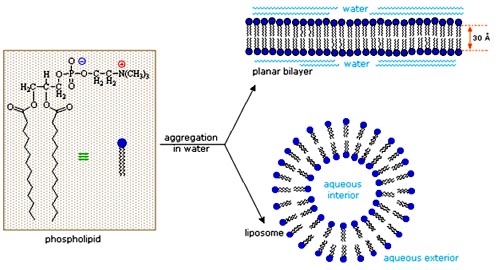
Staining for fatty acids, triglycerides, lipoproteins, and other lipids is done through the use of lysochromes (fat-soluble dyes). These dyes can allow the qualification of a certain fat of interest by staining the material a specific color. Some examples: Sudan IV, Oil Red O, and Sudan Black B.
Rancidity: Rancidification is the decomposition of fats and other lipids by hydrolysis and/or oxidation. Hydrolysis will split fatty acid chains away from the glycerol backbone in glycerides. These free fatty acids can then undergo further auto-oxidation. Oxidation primarily occurs with unsaturated fats by a free radical-mediated process i.e the formation of aldehydes due to the oxidation of unsaturated glycerides at their double bonds. These chemical processes can generate highly reactive molecules in rancid foods and oils, which are responsible for producing unpleasant and obnoxious odors and flavors. These chemical processes may also destroy nutrients in food. Under some conditions, rancidity, and the destruction of vitamins, occurs very quickly.
Antioxidants are often added to fat-containing foods in order to retard the development of rancidity due to oxidation. Natural anti-oxidants include flavonoids, polyphenols, ascorbic acid (vitamin C) and tocopherols (vitamin E). Synthetic antioxidants include butylated hydroxyanisole (BHA), butylated hydroxytoluene (BHT) and ethoxyquin. The natural antioxidants tend to be short-lived, so synthetic antioxidants are used when a longer shelf-life is preferred. The effectiveness of water-soluble antioxidants is limited in preventing direct oxidation within fats, but is valuable in intercepting free-radicals that travel through the watery parts of foods. A combination of water-soluble and fat-soluble antioxidants is ideal, usually in the ratio of fat to water.
Additionally, rancidification can be reduced (but not completely eliminated) by storing fats and oils in a place with little exposure to oxygen or free radicals, low temperature, and away from light. Light and heat warp the structure of fat, and greatly accelerate its reaction with oxygen.
Lipoproteins: A lipoprotein is a biochemical assembly that contains both proteins and lipids and may be structural or catalytic in function. Lipoproteins may be enzymes, proton pumps, ion pumps, for transport, or some combination of these functions.
General categories of lipoproteins, listed in order from larger and less dense (more fat than protein) to smaller and more dense (more protein, less fat):
Chylomicrons - carry triacylglycerol (fat) from the intestines to the liver and to adipose tissue.
Very low density lipoproteins (VLDL) - carry (newly synthesised) triacylglycerol from the liver to adipose tissue.
Intermediate density lipoproteins - are intermediate between VLDL and LDL. They are not usually detectable in the blood.
Low Density Lipoproteins (LDL) - carry cholesterol from the liver to cells of the body. Sometimes referred to as the "bad cholesterol" lipoprotein.
High Density Lipoproteins (HDL) - collects cholesterol from the body's tissues, and brings it back to the liver. Sometimes referred to as the "good cholesterol" lipoprotein.
Important Properties of Lipids:
Saponification Number – The number of mg of KOH required to saponify 1g of fat or oil. Each fatty acid residue in the triglyceride uses one KOH molecule for being saponified. So, the amount of KOH used by 1g fat is inversely proportional to the average molecular weight of the fatty acids in the fat.
Acid Number – The number of milligrams of KOH required to neutralize the free fatty acid of 1gram of fat. Free fatty acids, liberated in a neutral fat due to hydrolysis by Lipases, may contribute towards rancidity. So, a high acid number indicates a higher tendency for rancidity.
Iodine Number – This is amount (in grams) of Iodine absorbed by 100g of fat. Iodine is absorbed only at the double bonds of unsaturated fatty acid residues of triglycerides. So, the iodine number gives an estimate of the degree of unsaturation and the relative amounts of unsaturated fatty acids in the fat molecules.
Polenske Number – The number of oml of 0.1 N KOH required to neutralize the Insoluble fatty acids from 5g of fat. Reichert – Miessel Number: This is same as Polenske number except that the soluble fatty acids are measured by titration of the distillate by steam distillation of the saponification number.
Halogenation: Chlorine, Bromine, Iodine atoms may be added to double bonds of unsaturated fatty acids.
Amphipathic lipids in association with water form complexes in which their polar regions are in contact with water and their hydrophobic regions are away from water. Depending on the lipid, possible molecular arrangements include Various micelle structures. E.g., the spherical micelle is a stable configuration for amphipathic lipids that have a conical shape, such as fatty acids.

A bilayer. This is the most stable configuration for amphipathic lipids with a cylindrical shape, such as phospholipids.
Liposomes or small lipid vesicles, which can then be used to transport materials into living organisms and study diffusion rates into or out of a cell membrane

Staining for fatty acids, triglycerides, lipoproteins, and other lipids is done through the use of lysochromes (fat-soluble dyes). These dyes can allow the qualification of a certain fat of interest by staining the material a specific color. Some examples: Sudan IV, Oil Red O, and Sudan Black B.
Rancidity: Rancidification is the decomposition of fats and other lipids by hydrolysis and/or oxidation. Hydrolysis will split fatty acid chains away from the glycerol backbone in glycerides. These free fatty acids can then undergo further auto-oxidation. Oxidation primarily occurs with unsaturated fats by a free radical-mediated process i.e the formation of aldehydes due to the oxidation of unsaturated glycerides at their double bonds. These chemical processes can generate highly reactive molecules in rancid foods and oils, which are responsible for producing unpleasant and obnoxious odors and flavors. These chemical processes may also destroy nutrients in food. Under some conditions, rancidity, and the destruction of vitamins, occurs very quickly.
Antioxidants are often added to fat-containing foods in order to retard the development of rancidity due to oxidation. Natural anti-oxidants include flavonoids, polyphenols, ascorbic acid (vitamin C) and tocopherols (vitamin E). Synthetic antioxidants include butylated hydroxyanisole (BHA), butylated hydroxytoluene (BHT) and ethoxyquin. The natural antioxidants tend to be short-lived, so synthetic antioxidants are used when a longer shelf-life is preferred. The effectiveness of water-soluble antioxidants is limited in preventing direct oxidation within fats, but is valuable in intercepting free-radicals that travel through the watery parts of foods. A combination of water-soluble and fat-soluble antioxidants is ideal, usually in the ratio of fat to water.
Additionally, rancidification can be reduced (but not completely eliminated) by storing fats and oils in a place with little exposure to oxygen or free radicals, low temperature, and away from light. Light and heat warp the structure of fat, and greatly accelerate its reaction with oxygen.
Published date : 21 May 2014 03:17PM










